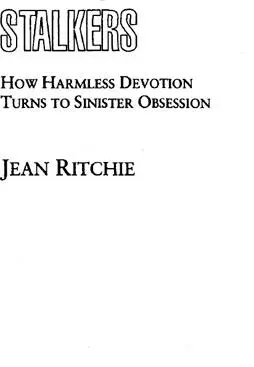
COPYRIGHT
Fourth Estate
An imprint of HarperCollins Publishers Ltd.
1 London Bridge Street
London SE1 9GF
www.harpercollins.co.uk
Copyright © Jean Ritchie 1994
Jean Ritchie asserts the moral right to be identified as the author of this work
A catalogue record for this book is available from the British Library
All rights reserved under International and Pan-American Copyright Conventions. By payment of the required fees, you have been granted the nonexclusive, nontransferable right to access and read the text of this ebook on-screen. No part of this text may be reproduced, transmitted, downloaded, decompiled, reverse-engineered, or stored in or introduced into any information storage and retrieval system, in any form or by any means, whether electronic or mechanical, now known or hereafter invented, without the express written permission of HarperCollins ebooks
HarperCollins Publishers has made every reasonable effort to ensure that any picture content and written content in this ebook has been included or removed in accordance with the contractual and technological constraints in operation at the time of publication
Source ISBN: 9780006383383
Ebook Edition © OCTOBER 2016 ISBN: 9780008226930
Version: 2016–11-08
CONTENTS
Cover
Title Page
Copyright
Introduction
PART ONE – THE PRICE OF FAME
‘You Can Run, But You Can’t Hide’
‘Bang, Bang, You’re Dead’
‘The Benevolent Angel of Death’
‘Don’t Say I Didn’t Warn You’
‘He’s Out There Somewhere’
‘Your Number One Fan’
PART TWO – YOU WILL SEE A STRANGER
‘I’ve Had One of Those Calls’
‘A Blight On Our Lives’
‘The Nightmare was Real’
PART THREE – WHEN FRIENDSHIP TURNS TO FEAR
‘Wherever I Went, He Followed’
‘I Didn’t Want to Hurt His Feelings’
‘He Has Invaded My Life’
‘Happy Valentine’s Day’
‘A Fatal Attraction’
PART FOUR – IN THE NAME OF LOVE
‘The Doors Are Locked, Aren’t They, Mummy?’
PART FIVE – THE STALKERS’ PERSPECTIVE
‘I Just Wanted to Take Care of Her’
PART SIX – REMEDIES, PRECAUTIONS AND THE LAW
‘A Paper Shield’
Keep Reading
Index
Acknowledgements
About the Author
About the Publisher
INTRODUCTION
‘IT’S THE NIGHTS that are the worst. I don’t know where he is, but my imagination tells me he is close at hand. In daylight I can keep the fears down; at night I am alone with the terror that he has created. If he rings me every ten minutes I think I will go mad with it; if he does not ring I worry that he is outside, watching me.’
The words of one stalking victim are echoed time and time again through the pages of this book. All stalking victims have different stories to tell, but all have one thing in common: fear. Stalking is a modern crime, a growing crime, a crime born out of loneliness and isolation. In America, where stalking has been studied and analysed far more than it has in Britain, there are an estimated 200,000 people who are being stalked, and the country’s greatest expert on the subject says that one in five women will at some time in their lives be the victim of unwanted pursuit.
In Hollywood, the most famous celebrities may have as many as five hundred people each writing ‘inappropriate’ letters to them, any one of whom may tip over the edge and become a dangerous stalker.
Pursuing celebrities is the type of stalking that makes the headlines, and for that reason it has defined the popular image of the problem. Nobody is surprised to find that a sexy young film starlet gets a barrage of kinky letters from lonely men. But stalking is not just about obsessional fans who turn up outside Hollywood mansions with knives or loaded guns in their pockets: stalking exists in all walks of life, it crosses all age and gender barriers, it knows no class distinctions. Even in California, the capital of the film industry, where the problems for celebrities are much greater than they are anywhere else in the world, celebrity stalking accounts for fewer than half of all cases. Elsewhere in America it is less than ten per cent, a figure that is probably consistent with British experience, although no comparable research has been carried out.
The dictionary definition of stalking is ‘to pursue prey stealthily’, and that is exactly what the human stalker does. His technique may be to make endless phone calls, or to send unwanted taxis and pizza deliveries, or to mail a stream of obscene letters. He may threaten violence, and he may even carry out his threats. Or he may simply, boringly, repetitively, to the point of persecution, try to insinuate himself in someone else’s life. However he does it, he is the hunter and his victim is the prey: he is a stalker.
Not all stalkers, of course, are male, there are some female stalkers about. More women become involved in celebrity stalking – pursuing an unattainable figure from a distance – than any other kind. But the majority of stalkers, more than eighty-five per cent, are men, according to American statistics. For them, stalking is connected with control; they want power over their victims and they can achieve this by frightening them, or – more simply – by knowing everything about their lives.
For the purposes of this book, stalking has been broken down into four broad categories: celebrity stalking, stalking by a complete stranger, stalking by an acquaintance and stalking by an ex-partner (boyfriend, girlfriend, husband, wife). This last category is the largest but also the hardest to define: ex-partners often behave with irrational jealousy, and that behaviour alone does not make them into stalkers. They usually have genuine ties with their victims: there may be children in common, property in common, or at least a social life in common, and the break can be emotionally devastating, leading to a certain amount of clinging on, refusing to give up. But there comes a point when this is no longer the acceptable reaction of a grieving ex. Recognizing that point may be hard (it is hard for all stalking victims, whatever category they come into, but especially hard for this group). When there are phone calls coming at all hours day or night, when there is a car parked outside or a figure lurking in the shadows, that is stalking. Because of the severed emotional ties it is often more difficult for the victim to deal with it, and more difficult for the stalker to accept that his or her behaviour is objectionable.
Stalking by someone who is known to the victim is the second biggest category. A casual acquaintance suddenly starts to take an overwhelming interest in all the details of their victim’s life, they misinterpret small gestures of friendship into large expressions of love, they begin to write, phone, follow the person they are fixated on. As they get no encouragement they feel rejected, and that turns their love into hatred. Threats and obscenities usually follow.
This pattern is repeated by the stalkers who latch on to complete strangers, as well as by those who persecute celebrities. In both these groups, the pursuit is of an unrealistic ideal: the stranger or the celebrity is endowed with all the attributes the stalker is looking for in a partner. Their beliefs about their love-object may go off the sanity scale, but they are deeply held. Gay pop singer Boy George enjoyed the joke immensely when a woman claimed he was the father of her child. He delighted in telling the journalists outside the court in which she sued him for maintenance for the child that it would be a miracle if he was the father as ‘I have never penetrated a woman in my life.’ Yet there was a part of the woman that believed her own wild claims.
Читать дальше













